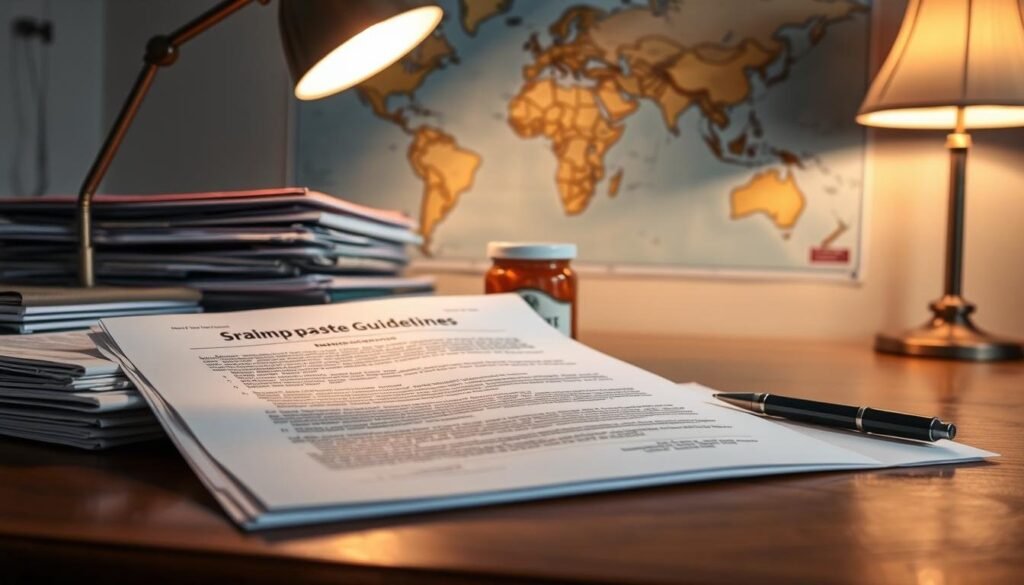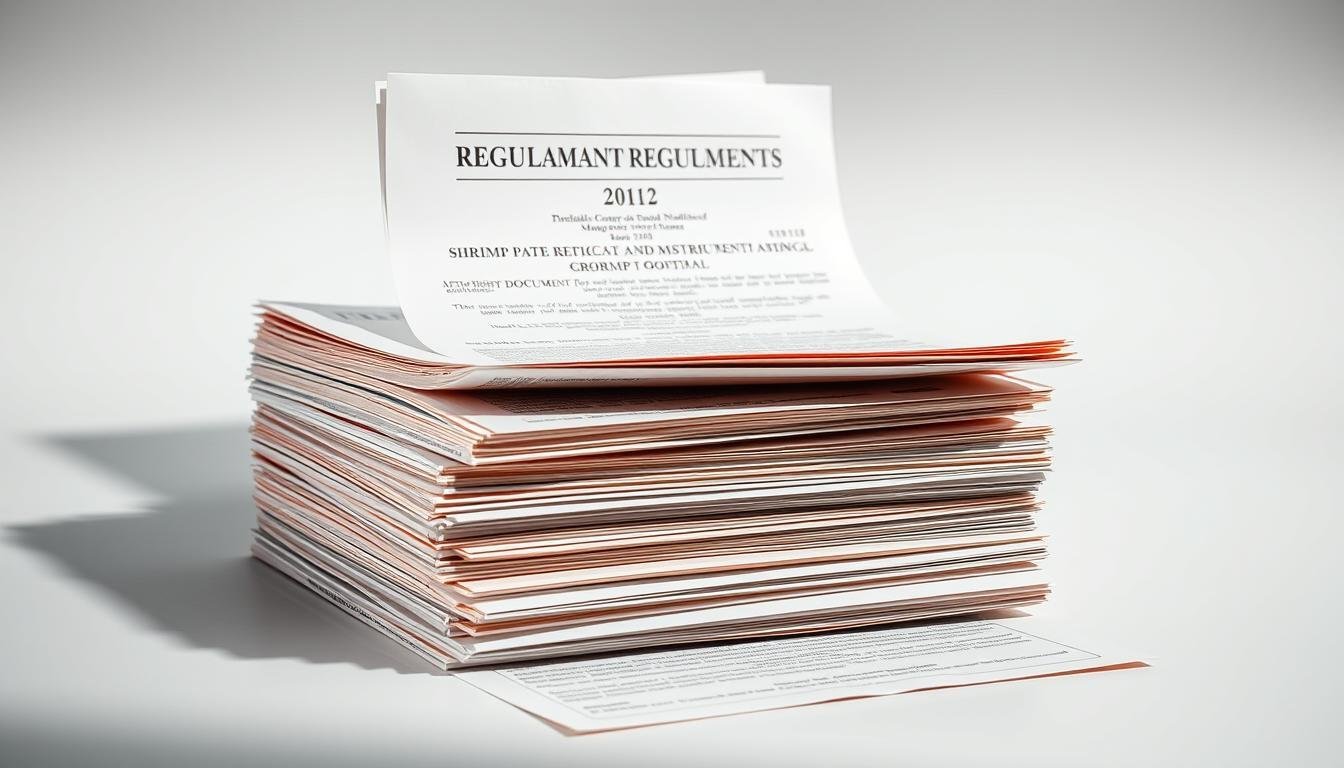You might have seen shrimp paste while looking into international food, especially in Southeast Asian dishes. It’s famous for its deep umami taste. But, its use is controlled by different rules.
Knowing about US shrimp paste laws is key if you love food or cook professionally. The rules around shrimp paste are detailed. They cover food safety and import rules.
When you cook with ingredients from around the world, knowing these laws is important. It helps you decide if you can use shrimp paste in your dishes. Let’s explore these laws and what they mean for you.
Contents
- 1 What is Shrimp Paste and Its Culinary Significance
- 2 Is Shrimp Paste Banned in the US? Current Legal Status
- 3 Reasons Behind Shrimp Paste Regulations
- 4 Finding and Using Legal Shrimp Paste in the US
- 5 Summary of Shrimp Paste Regulations in the US
- 6 FAQ
- 6.1 What is shrimp paste and is it safe to consume?
- 6.2 Is shrimp paste banned in the United States?
- 6.3 How can I find legal shrimp paste in the US?
- 6.4 What are the FDA guidelines on shrimp paste?
- 6.5 Can I cook with shrimp paste safely?
- 6.6 What are the environmental impact considerations related to shrimp harvesting for shrimp paste?
- 6.7 Are there any health and safety concerns associated with consuming shrimp paste?
What is Shrimp Paste and Its Culinary Significance
Shrimp paste is a strong, fermented ingredient that adds depth to dishes. It’s called terasi in Indonesian. It’s made from fermented shrimp or krill, salt, and sometimes other things. The fermentation process makes it taste rich and umami, which is key in Southeast Asian cooking.
So, how do people use shrimp paste in cooking? It’s very versatile. You can find it in everything from spicy sambals to savory curries. In Southeast Asia, it’s mixed with chilies, garlic, and lemongrass to make tasty pastes and sauces.
Traditional Dishes Featuring Shrimp Paste
Shrimp paste is a big deal in many traditional dishes. In Indonesian cooking, it’s in sambal, a chili paste. In Malaysia, it’s in laksa, a spicy noodle soup. Thai dishes like nam prik, a spicy dip, also use it.
Shrimp paste is not just for Southeast Asian dishes anymore. Chefs and home cooks in the US are using it too. They add it to marinades, sauces, and dips. This is exciting because it brings new flavors to familiar dishes.
Exploring shrimp paste can open up a world of flavors. Whether you’re making traditional dishes or trying new ones, shrimp paste is worth trying. It can make any dish better.
Is Shrimp Paste Banned in the US? Current Legal Status
Many people wonder if shrimp paste is banned in the US. The truth is, its legal status is complex. It involves many rules and guidelines for its import and sale.
The FDA watches over shrimp paste closely. They have clear rules for its import and sale in the US. These rules help figure out if shrimp paste meets US standards.
FDA Guidelines on Shrimp Paste
The FDA treats shrimp paste like other seafood. They make sure it meets US safety standards. This includes checking for harmful substances like heavy metals and bacteria.
- Shrimp paste importers must ensure their products are free from contaminants and comply with FDA safety standards.
- Imports are subject to inspection by the FDA to verify compliance with these regulations.
- Manufacturers and importers are required to maintain records of their products’ compliance with FDA guidelines.
It’s essential for consumers and businesses alike to be aware of these regulations to ensure they are sourcing and consuming legal and safe shrimp paste products.
The FDA also has rules for labeling shrimp paste. They require accurate ingredient lists, nutritional info, and allergen warnings.
In short, shrimp paste isn’t banned in the US. But, its import and sale must follow strict FDA rules. Knowing and following these rules is key for selling and eating shrimp paste legally in the US.
Reasons Behind Shrimp Paste Regulations
Why is shrimp paste so strictly regulated in the US? It’s mainly because of health and safety, and the environment.
Shrimp paste can be contaminated with harmful germs like bacteria and viruses. This is a big worry. So, strict rules are in place for how it’s handled and made.
Health and safety concerns go beyond just germs. The high salt in shrimp paste can be bad for people with high blood pressure. Also, some might be allergic to shrimp or other ingredients, making clear labels very important.
Environmental Impact Considerations
Shrimp paste production affects the environment a lot. Shrimp fishing can harm marine habitats and ecosystems. To fix this, there are rules for sustainable fishing.
The table below shows some key environmental issues with shrimp paste production:
| Environmental Impact | Description | Regulatory Measure |
|---|---|---|
| Habitat Destruction | Shrimp harvesting can damage marine habitats. | Protected areas and sustainable fishing practices. |
| Bycatch | The catching of non-target species during shrimp harvesting. | Use of bycatch reduction devices. |
| Water Pollution | Processing and waste from shrimp paste production can pollute waterways. | Regulations on waste disposal and processing. |

In short, shrimp paste rules cover health, safety, and the environment. Knowing these rules helps you choose better shrimp paste for cooking.
Finding and Using Legal Shrimp Paste in the US
For those interested in cooking with shrimp paste, finding a reliable source is crucial. Despite regulatory challenges, shrimp paste is available in the US through various channels.
You can find shrimp paste in specialty Asian grocery stores or through online retailers that ship to the US. When buying shrimp paste online, ensure that the product complies with US regulations and is properly labeled.
Cooking with Shrimp Paste Safely
Cooking with shrimp paste requires some care to ensure safe consumption. Here are some tips:
- Always check the ingredient label for compliance with US regulations.
- Store shrimp paste in the refrigerator to maintain its quality and safety.
- Use shrimp paste in moderation due to its strong flavor and potential health considerations.
When cooking with shrimp paste, it’s essential to balance its strong umami flavor with other ingredients. Here’s a simple guide to get you started:
| Dish | Usage of Shrimp Paste | Additional Ingredients |
|---|---|---|
| Thai Curry | 1-2 teaspoons | Coconut milk, lemongrass, chilies |
| Southeast Asian-Style Soup | 1 teaspoon | Broth, vegetables, herbs |
| Stir-Fry | 1/2 teaspoon | Vegetables, garlic, soy sauce |
By following these guidelines and being mindful of the source and usage of shrimp paste, you can enjoy this flavorful ingredient safely and deliciously.
Summary of Shrimp Paste Regulations in the US
You now know the legal status of shrimp paste in the US. The rules about shrimp paste are shaped by food safety and import rules.
Shrimp paste isn’t banned in the US, but it has some rules. You can buy legal shrimp paste at specialty stores or online. These places follow FDA rules.
When cooking with shrimp paste, buy it from a trusted source. Also, handle and store it right. This way, you can enjoy its taste and health benefits safely.
Exploring international dishes? Knowing shrimp paste rules helps. You can use it in your recipes, knowing you follow US laws.
Remember, knowing food ingredient rules is key. This is especially true for unique items like shrimp paste. Being informed makes cooking safer and more fun.
FAQ
What is shrimp paste and is it safe to consume?
Shrimp paste is a fermented condiment made from shrimp, salt, and sometimes other ingredients. It’s safe to eat when sourced and cooked right. But, it can be risky if contaminated or not handled correctly.
Is shrimp paste banned in the United States?
Shrimp paste isn’t banned in the US, but its import and sale are regulated by the FDA. Some types or sources might be restricted due to contamination risks or safety concerns.
How can I find legal shrimp paste in the US?
Legal shrimp paste can be found in specialty stores, Asian markets, or online. Look for products labeled as compliant with US regulations or inspected by authorities.
What are the FDA guidelines on shrimp paste?
The FDA has guidelines for shrimp paste under its seafood product regulations. These focus on safety and labeling. Imported shrimp paste must meet these standards to be sold in the US.
Can I cook with shrimp paste safely?
Yes, you can cook with shrimp paste safely. Just follow proper handling and cooking techniques. Cooking it thoroughly helps minimize the risk of foodborne illness.
Shrimp harvesting for shrimp paste can harm the environment, like habitat destruction and bycatch. Some producers use sustainable practices. Look for certifications or labels that show environmentally friendly sourcing.
Are there any health and safety concerns associated with consuming shrimp paste?
Yes, there are health and safety concerns. These include the risk of contamination with pathogens or heavy metals. Proper handling, storage, and cooking can reduce these risks.

Marcellus Stark is an investigative journalist from San Francisco, USA. He writes about global bans, rules, and unusual laws. He shares clear, interesting, and well-researched stories that help readers understand surprising facts worldwide.

